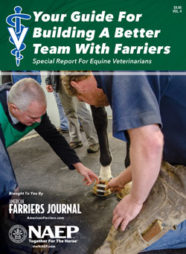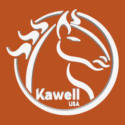Ron Rubin (West Palm Beach, Fla.)

There are farriers, and then there are artists. They both nail steel onto horses’ feet. But it is in the shaping of the hoof, the trimming of the heels, the rocker on the toe, and the balance that results that the artists also shape horses’ lives. Ron Rubin is an artist. Having shod for over 45 years – including a 14 year stint for Margie Engle – there isn’t much Ron hasn’t seen, or done.
"Leave A Little Foot On There"
In the 18 months I spent working with Ron, I can’t remember how many times I heard these words. In farrier work, there are no take backs, and what foot you take off, you can’t put back on. But, even having a background in psychology and kinesiology, I had never considered that a foot could become “traumatized”.
Pulling up at one of the larger show jumping barns in south Florida that day, I thought we were just going to nail a shoe back on for a fellow farrier who was out of town. But when we arrived and Ron took a look at the foot, he turned to me and said, “That’s a shut-down foot.” Glancing down at the foot, one thing was clear – the foot was way too short for the size of the horse – a towering 17 hands. “What do you mean?” I asked. “That foot’s been traumatized, and it stopped growing. That’s why he’s having trouble keeping a shoe on,” Ron explained, turning back toward his trailer. “So what are we going to do?” I asked, following him. “We are going to hot fit it back on and use Jesus Christ nails,” Ron said grinning. “Jesus what nails?” (I later learned the story behind Jesus Christ nails: Once when shoeing a horse with no foot and no quarters and nailing into the heels and toes, Shamus Grady looked at Ron’s nails and exclaimed in his thick Irish accent, “Ron, only Jesus Christ outs nails back that far!”)

Forty-five minutes, a hot fit, some scary looking nails, and a half a jar of acrylic glue later, the shoe was back on. As we left, Ron called the horse’s regular farrier and told him to leave the shoe on as long as it will stay. “See that’s what happens when these guys take too much foot off, and it shuts down and stops growing. Then they keep cutting and before long, they got no foot left,” Ron explained as we made our way out of the farm. Some weeks later, Ron told me that the knife could be a farrier’s worst enemy. “When warm bloods first came to Florida, nobody knew how to shoe them,” he said. “But we learned the hard way – you gotta leave a little foot on them.” (Shoeing in South Florida, with high amounts of rain and humidity is very different from many other climates. As I quickly learned, especially in the summer months, horses’ feet can quickly go from solid, hard nailing surfaces, to something that resembles rotten wood.)
The Truth Is In The Trimming
As a competitive show jumper for several years, the only question I ever asked was, “Is the shoe on or off?” Yet in farrier work, that is probably the least important question. Trim a horse too high on the outside – especially if he’s valgus – and it won’t be the shoe that’s off, it will be the horse. Or cut a clubfoot too short in the toe. Or leave a pigeon toed horse high on the outside. Or lose the anterior-posterior balance and leave the hoof extending way out in front. All of these things could lead to a lame horse. Farriers hold so much more than the horse’s hoof in their hands. They often hold the horse’s future. A “mismanaged foot” quickly becomes a “bad footed horse”. It’s true that farrier work is one part shoeing, and one part trimming, however, the parts are seldom equal. No amount of pour in sole pack, leather pads, special shoes, or copper nails will make up for a horse that is just badly trimmed.
You Gotta Feel Them Out

Give anyone a hammer and some nails and they can probably get a shoe on. They can probably also put a nail in the wall to hang a picture, nail a loose board, and maybe even fix a few jump standards. But they are not all the same. The horse, after all, is alive. “Ah, ah, ah. You see that, right there?” Ron looked up, the group of people surrounding him watching closely. Another farrier had just shod the horse in question, as myself, Ron, and a handful of others had met at the farm to fill in for a farrier who had been injured and would be out for a while. The problem was, after nailing the shoe on, the horse had walked off lame. The trainer quickly turned around and asked Ron to take a look. After the shoe had been pulled, and the sole pressure relieved, Ron proceeded to nail the shoe back on – slowly.
As I had seen him do many times, he was feeling the horse with each tap. One at a time, he softly hit the nail, only with this last one; the horse jerked its leg ever so slightly. Ron quickly pulled the nail out, repositioned it, and started again. This time, no jerk. Then he turned to me, “Claire when you clinch that, don’t press down real hard.” I had heard this before too. Watch everything – from the minute you pick up the leg, to the last time you set it down – it is the horse that tells you. If you pay attention, that is. “Half a millimeter sometimes,” Ron had told me. “That’s the difference between lame and sound.” “Of course, if you’re that short, you might already be in trouble,” he’d added. The point was not lost – shoeing a horse, like riding a horse, requires feel. Feel that is only learned through years – in Ron’s case, 45 years – of hard earned experience.
— Claire Dorotik-Nana (Fort Lauderdale, Fla.)






